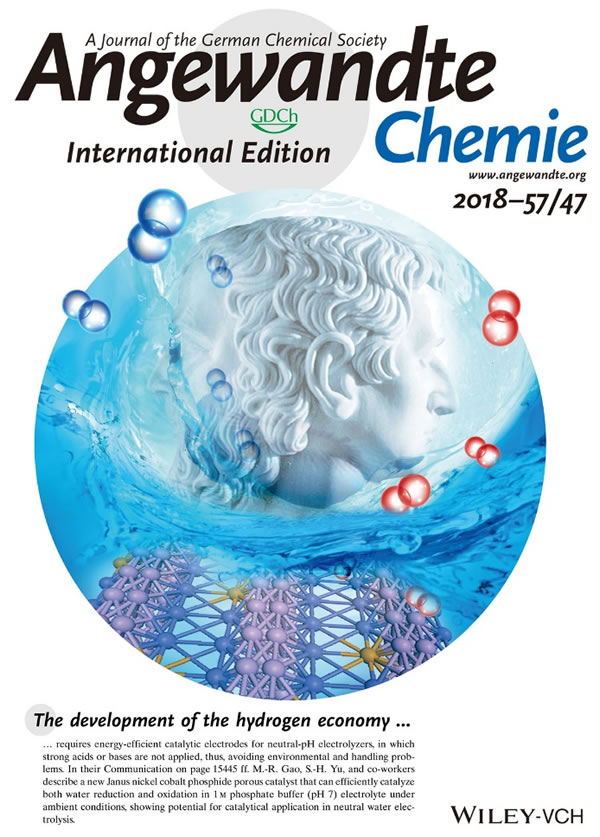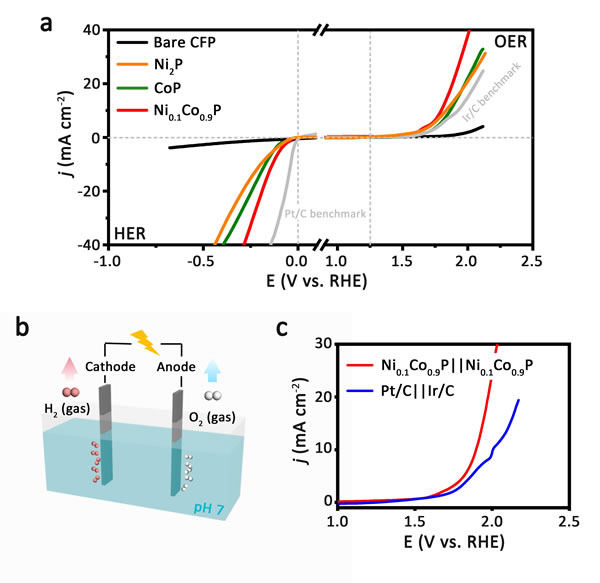Hydrogen energy has attracted wide attention as a high-energy, clean and renewable energy source. The preparation of hydrogen by electrochemical hydrolysis is one of the current research hotspots. In recent years, the design and preparation of fully hydrolyzed electrode catalysts have achieved remarkable research results. However, finding a water oxidation and reduction non-noble metal electrocatalyst that can simultaneously exhibit high activity and high stability in a neutral aqueous electrolyte is still a major challenge in the research field of hydrogen production from electrolytic water.
Recently, the team of professor Yu Shuhong and Gao Minrui of the University of Science and Technology of China designed and successfully prepared a nickel-doped cobalt phosphide (Ni0.1Co0.9P) ternary using a simple two-step reaction of electrochemical deposition and solid phase phosphating Nanosheet electrocatalyst. Compared to pure Ni2P and CoP, the doped material exhibits excellent water reduction and oxidation electrocatalytic activity and stability under neutral conditions. The experimenters used this ternary material as the cathode and anode of a neutral water total decomposition electrolytic cell, and found that its performance was superior to that of electrolytic cells prepared with commercial precious metal materials as electrodes. The research results were titled A Janus Nickel Cobalt Phosphide Catalyst for High-efficiency Neutral-pH Water Splitting, published in the German Journal of Applied Chemistry (Angew. Chem. Int. Ed. 2018, 57, 15445 – 15449), and were Selected as Hot Paper and inner back cover. The co-first authors of the paper are Wu Rui, a PhD student of the Chinese University of Science and Technology, Xiao Bing, a professor at Xi'an Jiaotong University, and Gao Qiang, a special associate researcher at the Chinese University of Science and Technology.
The Ni0.1Co0.9P ternary nanocatalyst prepared by the researchers has a porous structure, which is beneficial to the mass transfer process in electrochemical reactions. In a neutral electrolyte, the water reduction current density needs to be 125 mV when the current density reaches 10 mA / cm2, and the water oxidation reaction needs a potential of 1.79 V when the current density reaches 10 mA / cm2. The catalytic performance of Pt / C and Ir / C electrocatalysis is comparable. The mechanism study shows that this new Ni0.1Co0.9P ternary nanosheet is compared with the pure CoP structure. The doping of Ni atoms causes the unit cell to shrink, which compresses the bond length of the Co-P bond and causes local Co. Increased oxidation state. Theoretical calculation results confirm that this change in electronic state caused by Ni doping will reduce the adsorption free energy of the active site and the intermediate product during the neutral water oxidation and reduction reaction, giving the catalyst excellent catalytic performance.
The researchers further used the prepared Ni0.1Co0.9P ternary nanocatalyst as a double electrode to construct a water-decomposition electrolytic cell. The experimental results show that the performance of the device is better than that of the electrolytic cell constructed with commercial Pt / C || Ir / C as the electrode material in the neutral water electrolyte, which shows the potential of industrial-grade electrolytic water to produce hydrogen. This work provides new research ideas for the development of cheap ternary transition metal phosphides as electrodes for hydrogen production from neutral water electrolysis, and shows potential commercial application prospects.
The research was supported by the National Natural Science Foundation of China Innovation Research Group, the National Natural Science Foundation Key Fund, the National Major Scientific Research Program, the Chinese Academy of Sciences Frontier Science Key Research Project, the Chinese Academy of Sciences Nanoscience Excellence Innovation Center, the Suzhou Nanotechnology Collaborative Innovation Center, Hefei Science Funded by the Center's Excellent User Fund.

Figure 1. The job is selected as the inside-back cover paper

Figure 2. (ac) Ni0.1Co0.9P ternary nano-electrocatalyst water oxidation and water reduction catalytic activity and device performance evaluation
Curtain Motor support wifi, 433 communication frequency, support phone remote control, intermediate point limit function, built-in control module, control ability, strong anti-jamming capability, ultra-quiet operation, suitable for high quality electric screen, family office and other places of business.
Include following devices:
1.smart finger print lock
2.Flat open curtain motor
3.Intelligent shutter motor
4.Intelligent Flat open curtain motor
5.Orbit including accessory belt
6.Opening and closing electric curtain remote control
7.Chain type window machine
8.Smooth window opening type
Smart Lock,Smart Home Lock,Smart Automation Lock,Smart Door Lock
Shenzhen Zhuohao Intelligent Electronic Development Co., Ltd. , https://www.szactop-smart.com